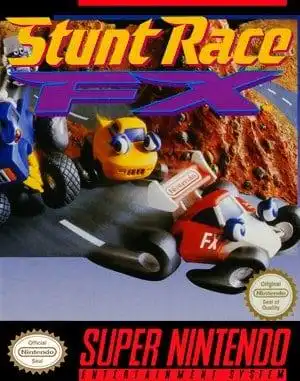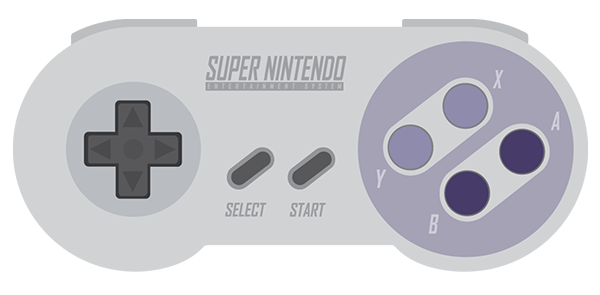Firing up the Super Nintendo back in the mid-90s often felt like stepping into the future, and few games promised that leap quite like Stunt Race FX SNES. This wasn't your typical sprite-based racer; this was Nintendo's bold, blocky dive into 3D polygons, powered by that magical little cartridge add-on, the Super FX chip. It arrived after the groundbreaking Star Fox (or Starwing for our PAL friends) and aimed to bring a different kind of polygonal action to the home console.
But was it the smooth, high-octane experience the box art hinted at? Or something a little... bumpier? Let's take a nostalgic look back at this fascinating, flawed, and undeniably charming piece of SNES history.
The Super FX Chip: Powering the Polygonal Dream
Before Stunt Race FX could even exist, Nintendo needed a way to push 3D graphics on the 16-bit SNES hardware. Enter the Super FX chip, developed by Argonaut Software. This co-processor inside the cartridge handled the complex calculations needed for rendering polygons, something the standard SNES CPU just couldn't do effectively on its own.
Star Fox showed us what was possible with space combat, but Stunt Race FX applied that tech to ground-based racing. It was visually striking for the time, featuring tracks with actual elevation changes, tunnels, and detailed (if blocky) environments that felt far more dynamic than the Mode 7 scaling seen in games like Super Mario Kart. It looked like the future, or at least, a glimpse of it from 1994.
Hitting the Track: Modes, Vehicles, and Quirks
Stunt Race FX wasn't short on ways to play, even if the core mechanics had their challenges. The game offered several modes:
- Speed Trax: The main campaign, a series of races against the clock (and a few rival cars) across various courses. The goal is reaching checkpoints before time runs out.
- Stunt Trax: Obstacle courses where you collect stars and navigate tricky terrain.
- Battle Trax: A two-player head-to-head mode on exclusive tracks.
- Free Trax: A practice mode on the Speed Trax courses without the pressure of the timer.
- Test Run: A basic practice area to get a feel for the controls.
You also had a choice of vehicles, each with different stats:
- Coupe: The balanced, default car.
- 4WD: Better grip, slower top speed.
- F-Type: Faster top speed, trickier handling.
- Trailer: An unlockable, difficult-to-control truck mode.
And who could forget the cars themselves? They had expressive, blinking eyes! It was a quirky touch that added to the game's unique personality, hinting at a slightly more lighthearted, perhaps kid-focused, design than its technical ambition might suggest.
The Bumpy Ride: Controls, Frame Rate, and Frustration
Now, let's talk about the elephant in the polygonal room: the performance and controls. While the 3D graphics were revolutionary for the SNES, they came at a significant cost. The frame rate was notoriously low, often estimated to be in the 10-15 frames per second range, sometimes dipping even lower.
This wasn't just a visual annoyance; it directly impacted gameplay. The low frame rate combined with what many players felt were heavy, slightly delayed controls made navigating the tracks a constant battle. Turning felt sluggish, and hitting walls (which happened a lot) would chip away at your car's health, risking a total breakdown. The "stunt" aspect often felt less like intentional flair and more like accidental flailing due to the imprecise steering.
Beating the time limits in Speed Trax became the primary challenge, less about outmaneuvering opponents and more about wrestling with the car and the environment. Stunt Trax, requiring precision, could be particularly frustrating.
Nostalgia vs. Reality: Does it Hold Up Today?
Revisiting Stunt Race FX today is an interesting experience. For those who played it back then, the nostalgia is powerful. You remember the excitement of seeing those 3D tracks, the catchy music, and the distinct look of the cars.
However, playing it now, especially if you're used to modern racing games or even smoother retro titles, highlights its technical limitations starkly. The low frame rate can be jarring, and the controls still feel heavy. Some players even report motion sickness due to the camera movement and choppy visuals.
Compared to the buttery smooth Mode 7 of F-Zero or the tight, accessible karting of Super Mario Kart, Stunt Race FX feels like a proof-of-concept that was pushed into a full retail release. It's a technical marvel of its era, but perhaps not a timeless gameplay classic for everyone.
The Legacy of Stunt Race FX
Despite its flaws, Stunt Race FX holds a unique place in the SNES library. It was one of the most prominent examples of the Super FX chip's capabilities and a pioneering attempt at bringing true 3D racing to a home console before the PlayStation or Nintendo 64 arrived.
It's a game that's perhaps more appreciated for its historical significance and ambitious vision than for its raw playability by modern standards. It represents a moment when Nintendo was pushing boundaries, experimenting with new technology to see what was possible.
So, is Stunt Race FX SNES worth playing today? If you have a fascination with retro gaming history, early 3D graphics, or simply want a potent dose of mid-90s Nintendo quirkiness, absolutely. Just be prepared for a ride that's less smooth highway and more bumpy, polygonal backroad. It's a fascinating artifact from a pivotal time in gaming, even if it might make you a little dizzy along the way.
Stunt Race FX SNES FAQ
What was the Super FX chip used for in Stunt Race FX?
The Super FX chip was a co-processor inside the cartridge that allowed the SNES to render the game's polygonal 3D graphics, which the console's main CPU couldn't handle on its own.
Why is the frame rate in Stunt Race FX so low?
Rendering complex 3D polygons was very demanding for the SNES hardware, even with the Super FX chip. The low frame rate was a technical limitation of pushing that level of 3D detail on a 16-bit system.
Are the controls in Stunt Race FX difficult?
Many players find the controls heavy and somewhat unresponsive, partially due to the low frame rate. It takes time to get used to the delayed input and the feel of the cars.
How many vehicles are there in Stunt Race FX?
There are four main vehicles you can drive: the Coupe, 4WD, F-Type, and an unlockable Trailer truck. They each have different handling characteristics.


